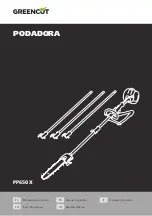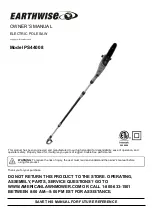
5
3.
Use only saw blades specified by the
manufacturer and which conform to EN847-1.
The groove width of the cut must be thicker
than the riving knife and the blade body must
be thinner than the riving knife.
4.
Do not use saw blades manufactured from
high speed steel.
5.
Wear eye protection.
6.
Wear hearing protection to reduce the risk of
hearing loss.
7.
Wear gloves for handling saw blades (saw
blades shall be carried in a holder wherever
practicable) and rough material.
8.
Connect the tool to a dust collecting device
when sawing.
9.
Always store the push-stick when it is not in use.
10.
Keep the floor area around the tool level well
maintained and free of loose materials e.g.
chips and cut-offs.
11.
The operator is adequately trained in the use,
adjustment and operation of the tool.
12.
Stop and unplug the saw when unattended.
13.
To reduce the emitted noise, always be sure
that the blade is sharp and clean.
14.
Use only saw blades that are marked with a
maximum speed equal to or higher than the no
load speed marked on the tool.
15.
When the tool is fitted with a laser or LED, do
not replace the laser or LED with a different
type.
Ask an authorized service center for repair.
16.
Never remove any cut-offs or other parts of the
workpiece from the cutting area whilst the tool
is running with an unguarded saw blade.
17.
The tool should not be used for slotting,
rebating or grooving.
18.
Before carrying the tool, always cover the upper
part of the saw blade by the top guard and secure
all moving portions. When lifting or carrying the
tool, do not use the guard as a carrying handle.
19.
Clean and be careful not to damage the
spindle, flanges (especially the installing
surface) and hex bolt before or when installing
the blade. Damage to these parts could result
in blade breakage. Poor installation may cause
vibration/wobbling or slippage of the blade.
Use only flanges specified for this tool.
20.
Always use accessories recommended in this
manual. Use of improper accessories such as
abrasive cut-off wheels may cause an injury.
21.
Select the correct saw blade for the material to
be cut.
22.
Do not cut metal objects such as nails and
screws. Inspect for and remove all nails,
screws and other foreign material from the
workpiece before operation.
23.
Knock out any loose knots from workpiece
BEFORE beginning to cut.
24.
Do not use the tool in the presence of
flammable liquids or gases.
25.
For your safety, remove the chips, small pieces,
etc. from the work area and table top before
plugging the tool and starting operation.
26.
Keep hands and make your bystander and
yourself position out of path of and not in line
with saw blade. Avoid contact with any
coasting blade. It can still cause severe injury
and never reach around saw blade.
27.
Be alert at all times, especially during
repetitive, monotonous operations. Do not be
lulled into a false sense of security. Blades are
extremely unforgiving.
28.
Make sure the shaft lock is released before the
switch is turned on.
29.
Before using the tool on an actual workpiece,
let it run for a while. Watch for vibration or
wobbling that could indicate poor installation
or a poorly balanced blade.
30.
Wait until the blade attains full speed before
cutting.
31.
Stop operation immediately if you notice
anything abnormal.
32.
Turn off tool and wait for saw blade to stop
before moving workpiece or changing
settings.
33.
Unplug tool before changing blade, servicing
or not in use.
34.
Some dust created from operation contains
chemicals known to cause cancer, birth
defects or other reproductive harm. Some
examples of these chemicals are:
−
lead from lead-based-painted material
and,
−
arsenic and chromium from
chemically-treated lumber.
Your risk from these exposures varies,
depending on how often you do this type of
work. To reduce your exposure to these
chemicals: work in a well ventilated area and
work with approved safety equipment, such as
those dust masks that are specially designed
to filter out microscopic particles.
35.
Even when the tool is used as prescribed it is
not possible to eliminate all residual risk
factors. The following hazards may arise in
connection with the tool’s construction and
design:
−
Damage to health resulting from hand-arm
vibrations if the power tool is used over a
longer period of time and is not operated
or serviced correctly.
Содержание LH1040F
Страница 21: ...21 ...
Страница 22: ...22 ...
Страница 23: ...23 ...
Страница 24: ...24 www makita com Makita Jan Baptist Vinkstraat 2 3070 Belgium Makita Corporation Anjo Aichi Japan 884548I224 ...






































